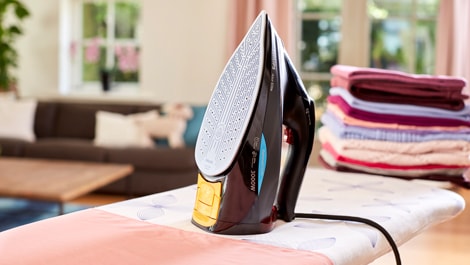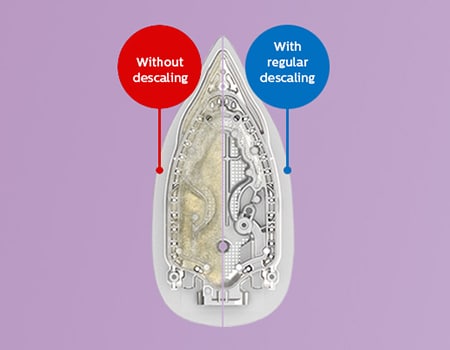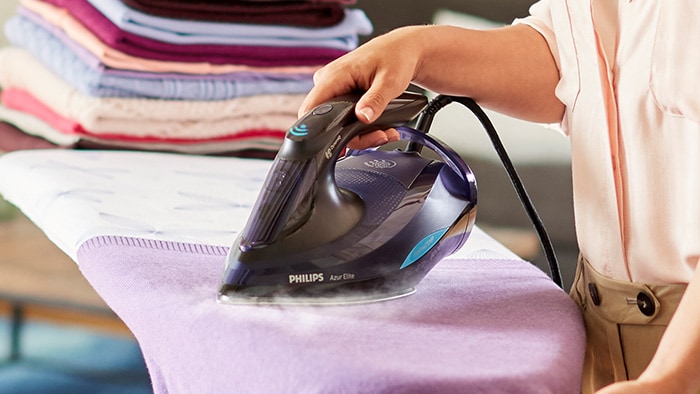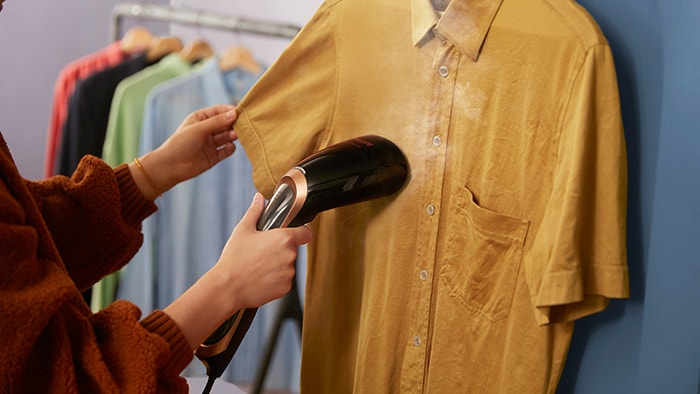You’ve done your weekly wash, and you’re prepping for the busy week ahead by making sure work shirts, office blouses, and uniforms are pressed. Then you notice a black, sticky mess on the bottom of your iron. Help! Luckily there are solutions at hand. Whether you’re looking to learn how to clean a sticky iron bottom or how to get burn marks off, iron cleaning is pretty straightforward when you know what you’re doing. Here’s some advice on how to clean an iron soleplate using home remedies (and some ways to keep your water reservoir tip-top too).
How to clean iron plates

How do you know if an iron needs cleaning? It’s easy to tell if the iron has visible burn marks or is sticky to the touch, but a clean iron soleplate should also move smoothly over your clothes without dragging or leaving marks.
Before cleaning an iron, ensure it’s unplugged and the plate has cooled down completely. One obvious way to clean an iron plate is to use an iron plate cleaner designed specifically for the purpose.
Alternatively, you can check some quick home remedies. Remember: whatever your method, test it on a small part of the plate before cleaning the rest, just in case it causes issues.
Home remedies to clean an iron soleplate
Soapy water – If your iron only needs a light clean, you can scrub it with a sponge dipped in soapy water. Don’t use wire wool – it’ll damage the plate. Toothpaste – When cleaning the iron soleplate, you could try using toothpaste. If it is still not clean after the soapy water treatment. Once the iron has dried, take a small blob of toothpaste and rub it all over the surface of the plate using an old rag or tea towel. Clean the toothpaste away with a damp sponge or cloth. Vinegar – You can also clean an iron with vinegar to get more stubborn marks or sticky residue off an iron. Lay down newspaper before you begin, because vinegar can damage stone or wooden surfaces. Here are the steps for how to clean an iron soleplate with vinegar:
Mix equal amounts of white vinegar and salt in a saucepan.
Heat the mixture gently (you’re just warming it up, not trying to boil it). Take the pan off the stove before you start cleaning.
Put on rubber gloves to protect your hands from the heat, then dip a sponge in the salt-and-vinegar mixture.
Gently scrub the bottom of the iron clean.
While methods for how to clean burnt iron marks and how to clean a sticky iron are generally similar, some might work better on certain iron problems.
However, to avoid dealing with burn marks at all, consider using a steam iron with an effective solution against limescale. Philips PerfectCare Elite Plus features an Easy De-Calc system that lets you know when it’s time to descale, while the DynamiQ smart sensor guarantees no burn or creases on all fabrics.
How to deal with scorch marks on clothes
If your clothes end up with scorch marks, don’t panic. First, check the iron’s soleplate for any residue that might be causing the problem. Clean it before using the iron again to prevent any further marks from getting onto your clothing.
Removing light scorch marks
White vinegar is an eco-friendly and effective way to treat light scorch marks on both white and coloured fabrics. Simply dab the scorched area with a cloth dipped in vinegar and let it sit for 15-20 minutes. Once the mark has lifted, rinse with cold water and wash the garment as normal.
Removing heavy scorch marks
For severe scorch marks, hydrogen peroxide is a great solution. Apply a small amount of hydrogen peroxide to the stained area using a cotton swab. Let it sit for five minutes before rinsing. This method is particularly useful on cotton or linen but should be used carefully as repeated applications can weaken the fabric.
Removing stubborn scorch marks
If vinegar alone doesn’t work, try making a baking soda paste by mixing three parts baking soda with one part water. Apply the paste to the scorch mark, let it sit for 10-15 minutes, then gently scrub it off with a toothbrush. This method is particularly useful for stubborn marks that won’t come off with simple solutions.
Preventing scorch marks
To avoid scorch marks altogether, use a pressing cloth between the iron and your fabric, especially when working with delicate fabrics. A thin cotton or muslin cloth acts as a protective layer, distributing the heat more evenly. This will prevent direct contact with the iron’s hot plate.
Maintaining your iron plate
To keep your iron in good condition and reduce the need for deep cleaning, do the following:
How to clean a steam iron water reservoir

Planning to descale the water reservoir of your steam iron? Check the manufacturer’s instructions to see if your iron has a self-cleaning function and learn more on how to clean a steam generator designed with easy descaling in mind.
However, if your iron doesn’t have a self-cleaning function, it’s up to you to sort out the reservoir.
White vinegar – white vinegar can help you here, but check the manufacturer’s instructions first as putting vinegar in the reservoir may not be recommended for your model.
Mix equal amounts of vinegar and water, put the mixture in the reservoir, turn the iron to medium heat and give it about ten minutes to steam.
Afterwards, empty the reservoir and fill it with distilled water. Turn the iron on and leave it to steam for another few minutes to remove the last of the vinegar.
Distilled water – if your iron’s manufacturer advises against vinegar, you can just fill the reservoir with distilled water. Turn it to medium heat and let it steam itself almost dry, without taking the step of using vinegar first. To help prevent limescale, always empty the water reservoir before you put your iron away.




